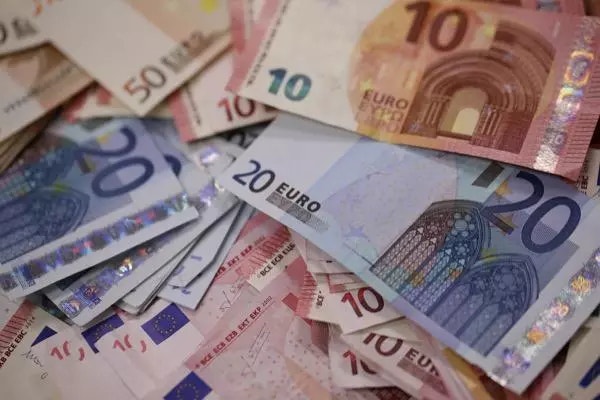What were the pre-euro currencies in Europe?

Which countries use the euro?
The countries that use the euro are often referred to as a collective called the eurozone. These are 19 of the European Union (EU) member states, with the remaining members electing to use their own forms of currency, such as the Polish złoty or the Hungarian forint. However, aside from Denmark, the remaining EU27 member states (after Brexit) will adopt the euro as their national currency at some point in the future, once certain criteria are met.
During the transition period, the euro was used alongside many national currencies for banking purposes, travellers’ cheques or online transactions before each pre-euro currency was phased out and replaced by euro banknotes and coins.
Former European currencies
- German Deutschemark (Germany)
- French franc (France)
- Italian lira (Italy)
- Spanish peseta (Spain)
- Dutch guilder (Netherlands)
- Belgian franc (Belgium)
- Austrian schilling (Austria)
- Irish pound (Ireland)
- Finnish markka (Finland)
- Portuguese escudo (Portugal)
German Deutschemark
The German Deutschemark (Deutsche Mark, DM or D-Mark) was the pre-euro currency of West Germany from 1948 until 1990, and then of the unified Federal Republic of Germany from 1990 until 2002. The unified Federal Republic of Germany adopted the Deutschemark – rather than the East German mark – because the unified country was seen as an enlarged continuation of West Germany, rather than an entirely new successor state.
The Deutschemark was regarded as one of the world’s most stable currencies at the time that the Berlin Wall fell. In the nine years before the introduction of the euro, the Deutschemark continued to thrive under the policies of the Bundesbank (German Central Bank), which favored tight monetary policy to reduce the risk of dramatic increases in inflation.
After the introduction of euro coins and notes on 1 January 2002, the euro became the official legal tender of Germany immediately. However, Deutschemark coins and notes continued to be accepted as payment until late February 2002, with the exchange rate for Deutschemarks to euros fixed at 1.95583 to one.
French franc
The French franc can trace its history back to the ransom of King John II of France in 1360, when the first franc was used to secure the king’s release. According to legend, the name for the French franc comes from Francorum Rex, a Latin phrase meaning ‘King of the Franks’.
The French franc is the first of the pre-euro currencies on this list to have been a part of the Latin Monetary Union (LMU), which was an early attempt to fix exchange rates across various European countries.
The LMU – which existed from 1866 until 1927 – didn’t seek to establish a single currency such as the euro. Instead, it sought to peg the value of certain European currencies to each other at a time when most currency in circulation was made from gold and silver.
Following the collapse of the LMU, the franc continued as the primary currency of France until it formally adopted the euro as fiat currency in January 2002. Francs were exchanged for euros at a fixed rate of 6.55957 to one, with the final date for exchange being 17 February 2005.
Italian lira
The Italian lira, sometimes referred to in plural form as lire, was the pre-euro currency of Italy from 1861 until 2002. In 1861, Italy ceased to be a collection of individual states and became the unified Kingdom of Italy (1861 to 1946). To counter the various currencies in use at the time across Italy, the lira was introduced and became the official currency of the newly unified state.
The lira was affected by inflation in the Italian economy from the 1970s until the country formally adopted the euro in 1999, at which point the production of lire banknotes and coins was halted in preparation for the release of euro-denominated notes and coins on 1 January 2002.
During this time, the lira was exchangeable at a fixed conversion rate of 1936.27 to the euro, which was maintained by the Banca d’Italia (Bank of Italy) until 2012.
Spanish peseta
The Spanish peseta was the pre-euro currency of Spain from 1868 until 2002. The peseta was divided into subunits of centimos, with 100 centimos being equal to one peseta. However, following the death of Spanish leader Francisco Franco in 1975, inflation began to climb in the Spanish economy. It got to such a point in the late 1970s and early 1980s, that the centimo was withdrawn from circulation in 1983 as it had become practically worthless.
After this time, frequently used peseta banknotes included the 1000, 2000 and 5000 denominations. However, the Spanish government took considerable steps to curb the effects of inflation from the early 1980s and by 1997, inflation in Spain had fallen to around 2%.
The Spanish peseta was used alongside the euro from 1999 until 2002, with the peseta no longer being accepted as legal tender after February 2002. Unlike some other currencies on this list, the peseta will be exchangeable with the euro at a fixed rate of 166.386 to one indefinitely. Transactions can be completed with the Banco de España (Bank of Spain).
Dutch guilder
The Netherlands used the Dutch guilder (gulden) as its official currency from around 1517 until 2002. The currency was decimalized in 1817 with one guilder being comprised of 100 cents.
Unlike some of the other old European currencies on this list, which circulated alongside the euro, the guilder stopped being legal tender on 28 January 2002 – a full month before currencies such as the Spanish peseta and the Austrian schilling.
The guilder was converted to the euro at a rate of 2.20371 to one, and the Nederlandsche Bank (National Central Bank of the Netherlands) will continue to exchange guilders for euros at this rate until 1 January 2032.
Belgian franc
The Belgian franc was the currency of the Kingdom of Belgium from when the country secured its independence in 1832, until the implementation of the euro in 2002. The Belgian franc was subdivided into units of 100, referred to as centiemen in Dutch.
In the 60 or so years before Belgium started using the euro, the franc was devalued on several occasions, first in 1944, and then in 1946, 1949 and finally in 1982. During this time, the Belgian franc also traded at par with the Luxembourgish franc, and each was legal tender in the other country.
Just like other countries on this list, the Belgian franc was used alongside the euro for three years from 1999, and it ceased being legal tender in February 2002. The Banque Nationale de Belgique (National Central Bank of Belgium) will continue to exchange Belgian franc banknotes indefinitely, although it stopped exchanging coins in December 2004.
Austrian schilling
The Austrian schilling was the pre-euro currency used by Austria between 1925 and 1938, and then again from 1945 until 2002. After Germany annexed Austria in 1938, the German Reichsmark replaced the schilling at a rate of two Reichsmarks to three schillings. The Austrian schilling was reintroduced on 30 November 1945 following the defeat of Germany in World War Two.
The Austrian schilling was divided into subunits called groschen, with 100 groschen making a schilling. Austria formally adopted the euro in 1999, though the schilling was still used alongside the euro until 2002.
Dual circulation ended on 28 February 2002, but the Österreichische Nationalbank (Austrian National Bank) continues to exchange schillings for euros at a rate of 13.7603 to one.
Irish pound
The Irish pound was initially known as the Saorstát pound and it was introduced in 1928, six years after the formation of the Irish free state in 1922. After 1938, the currency became widely known as the Irish pound, although it was pegged to the British pound at parity.
After 1938, the name ‘Irish pound’ was in widespread use and the currency was decimalised in 1971 while maintaining parity with the British pound. This changed in 1978, when Ireland elected to join the European Monetary System (EMS) but the UK did not. Within the EMS, the European Exchange Rate Mechanism (ERM) broke the peg between the Irish pound and the British pound, with a free-float exchange rate being introduced in 1979.
This meant that the currencies fluctuated against each other according to open market conditions. When the euro was adopted by Ireland, the exchange rate between Irish pounds and the euro was 0.787564 to one.
Finnish markka
The Finnish markka was the official currency of Finland from 1860 until 2002. The subunit of the markka was called the penni, with 100 pennies making a markka. Finland was one of the first countries to enter the eurozone, with the euro being used alongside the markka until 2002.
As with other countries who were quick to adopt the euro before 2002, this was to allow for a transitionary period of three years during which the euro would be used for bank transactions, travellers’ cheques and online transactions.
After the introduction of euro coins and banknotes on 1 January 2002, the markka continued to be accepted as legal tender until 28 February 2002. However, markka coins and notes were still exchangeable with euros at the Suomen Pankki (National Bank of Finland) until 2012, at a fixed rate of 5.94573 to one.
Portuguese escudo
The Portuguese escudo was the currency of Portugal from 1911 until 2002. The escudo replaced the real at a rate of 1000 real to one escudo following a Republican revolution which took place in 1910. The escudo often used ‘$’ to denominate escudos alongside centavos, which was the subunit of the escudo – similar to British pounds and pence or US dollars and cents. For example, 675$00 would be $675 escudo, while 43$87 would be $43 escudos and 87 centavos.
Because Portugal remained neutral during World War Two, the escudo was prized by Nazi Germany as a foreign currency reserve which could be used to make purchases from Portugal and other neutral nations.
Following the war however, the escudo was plagued by inflation which effectively made centavos worthless, with the Banco de Portugal (National Bank of Portugal) electing to print higher denominations of the escudo including 500$, 1000$, 5000$ and 10,000$. When Portugal joined the eurozone in 1999, the conversion rate of escudo to euros was set at 200$482 to one. As with other currencies on this list, there was a transition period of three years until 2002, during which the escudo and euro were used alongside each other in Portugal.
Pre-euro currencies summed up
- Many countries in Europe had their own unique pre-euro currency
- The euro was adopted in 1999 by many EU member states at the time
- While it was used in online transactions and between banks, euro banknotes and coins were not issued until 1 January 2002
- After euro banknotes and coins were introduced, different periods of dual circulation were in effect to enable the pre-euro currencies to be effectively phased out
- Not all EU member states currently use the euro as their main currency, although most are obliged to adopt the euro once they meet certain criteria
This information has been prepared by tastyfx, a trading name of tastyfx LLC. This material does not contain a record of our trading prices, or an offer of, or solicitation for, a transaction in any financial instrument. You should not treat any opinion expressed in this material as a specific inducement to make any investment or follow any strategy, but only as an expression of opinion. This material does not consider your investment objectives, financial situation or needs and is not intended as recommendations appropriate for you. No representation or warranty is given as to the accuracy or completeness of the above information. tastyfx accepts no responsibility for any use that may be made of these comments and for any consequences that result. See our Summary Conflicts Policy, available on our website.
